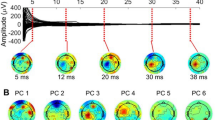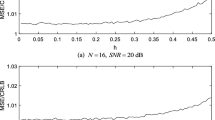Abstract
This paper considers mixing matrix estimation for underdetermined blind source separation. First, we propose an effective detection algorithm to identify single source points where only one source occurs. The detection algorithm finds single source points by utilizing the time–frequency coefficients of mixed signals and the complex conjugates of the coefficients. Then, a method based on probability density is proposed in order to find more reliable single source points and cluster them. Finally, the mixing matrix is obtained through re-selecting and clustering single source points. The experimental results indicate that the algorithm can accurately estimate the mixing matrix when there are fewer sensors than sources.



Similar content being viewed by others
References
F. Abrard, Y. Deville, A time–frequency blind signal separation method applicable to underdetermined mixtures of dependent sources. Signal Process. 85(7), 1389–1403 (2005)
A. Aissa-El-Bey, N. Linh-Trung, K. Abed-Meraim, A. Belouchrani, Y. Grenier, Underdetermined blind separation of non-disjoint sources in the time–frequency domain. IEEE Trans. Signal Process. 55(3), 897–907 (2007)
S. Arberet, R. Gribonval, F. Bimbot, A robust method to count and locate audio sources in a stereophonic linear instantaneous mixture. in 6th International Conference on Independent Component Analysis and Blind Signal Separation, Charleston, America (2006), pp. 536–543
S. Arberet, R. Gribonval, F. Bimbot, A robust method to count and locate audio sources in a stereophonic linear anechoic mixture. in Proceedings of ICASSP (2007), pp. 745–748
S. Arberet, R. Gribonval, F. Bimbot, A robust method to count and locate audio sources in a multichannel underdetermined mixture. IEEE Trans. Signal Process. 58(1), 121–133 (2010)
G. Chabriel, M. Kleinsteuber, E. Moreau et al., Joint matrices decompositions and blind source separation: a survey of methods, identification, and applications. IEEE Signal Process. Mag. 31(3), 34–43 (2014)
T. Dong, Y. Lei, J. Yang, An algorithm for under-determined mixing matrix estimation. Neurocomputing 104(15), 26–34 (2013)
Y. Guo et al., Edge effect elimination in single-mixture blind source separation. Circuits Syst. Signal Process. 32(5), 2317–2334 (2013)
S.G. Kim, C.D. Yoo, Underdetermined blind source separation based on subspace representation. IEEE Trans. Signal Process. 57(7), 2604–2614 (2009)
Y. Li, S. Amari, A. Cichochi, D.W.C. Ho, S. Xie, Underdetermined blind source separation based on sparse representation. IEEE Trans. Signal Process. 54(2), 423–437 (2006)
K. Liu, L. Du, J. Wang, Underdetermined blind source separation based on single dominant source areas. Sci. China Ser. E Inf. Sci. 38(8), 1284–1301 (2008)
G.R. Naik, Enhancement of the ill-conditioned original recordings using novel ICA technique. Int. J. Electron. 99(7), 899–906 (2012)
G.R. Naik, D.K. Kumar, An overview of independent component analysis and its applications. Int. J. Comput. Inf. 35(1), 63–81 (2011)
G.R. Naik, D.K. Kumar, M. Palaniswami, Signal processing evaluation of myoelectric sensor placement in low-level gestures: sensitivity analysis using independent component analysis. Expert Syst. 31(1), 91–99 (2014)
F. Nesta, T. Wada, B. Juang, Batch-online semi-blind source separation applied to multi-channel acoustic echo cancellation. IEEE Trans. Audio Speech Lang. Process. 19(3), 583–599 (2011)
M.S. Pedersen, D.L. Wang, J. Larsen et al., Two-microphone separation of speech mixtures. IEEE Trans. Neural Netw. 19(3), 475–492 (2008)
G. Pendharkar, G.R. Naik, H.T. Nguyen, Using blind source separation on accelerometry data to analyze and distinguish the toe walking gait from normal gait in ITW children. Biomed. Signal Process. Control 13, 41–49 (2014)
F. Poncelet, G. Kersehenq, J.C. Golinval, D. Vethelst, Output-only modal analysis using blind source separation techniques. Mech. Syst. Signal Process. 21(6), 2335–2358 (2007)
G. Qian, L. Li, M. Luo, On the blind channel identifiability of MIMO-STBC systems using non-circular complex FastICA algorithm. Circuits Syst. Signal Process. 33(6), 1859–1881 (2014)
V.G. Reju, S.N. Koh, I.Y. Soon, An algorithm for mixing matrix estimation in instantaneous blind source separation. Signal Process. 89(9), 1762–1773 (2013)
M. Xiao, S. Xie, Y. Fu, Undetermined blind delayed source separation based on single source intervals in frequency domain. Acta Electr. Sin. 35(12), 2367–2373 (2007)
J. Xu, X. Yu, D. Hu, L. Zhang, A fast mixing matrix estimation method in the wavelet domain. Signal Process. 95, 58–66 (2014)
X. Yu, T. Cao, D. Hu et al., Blind image separation based on wavelet transformation and sparse component analysis. J. Beijing Univ. Posts Telecommun. 33(2), 58–63 (2010)
X. Yu, J. Xu, D. Hu et al., A new blind image source separation algorithm based on feedback sparse component analysis. Signal Process. 93(1), 288–296 (2013)
K. Yu, K. Yang, Y. Bai, Estimation of modal parameters using the sparse component analysis based underdetermined blind source separation. Mech. Syst. Signal Process. 45(2), 302–316 (2014)
Acknowledgments
This work is supported by National Natural Science Foundation of China (No. 61301095), the Heilongjiang Province Natural Science Foundation (No. F201345) and the Fundamental Research Funds for the Central Universities of China (No. HEUCF150812).
Author information
Authors and Affiliations
Corresponding author
Rights and permissions
About this article
Cite this article
Li, Y., Nie, W., Ye, F. et al. A Mixing Matrix Estimation Algorithm for Underdetermined Blind Source Separation. Circuits Syst Signal Process 35, 3367–3379 (2016). https://doi.org/10.1007/s00034-015-0198-y
Received:
Revised:
Accepted:
Published:
Issue Date:
DOI: https://doi.org/10.1007/s00034-015-0198-y




